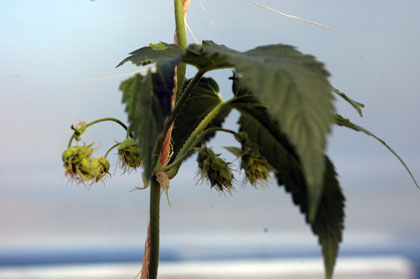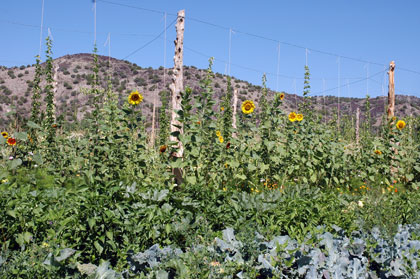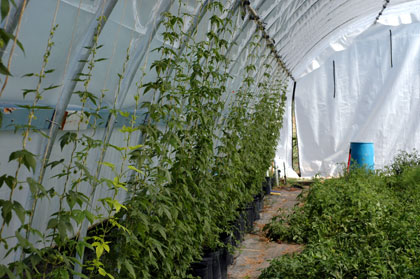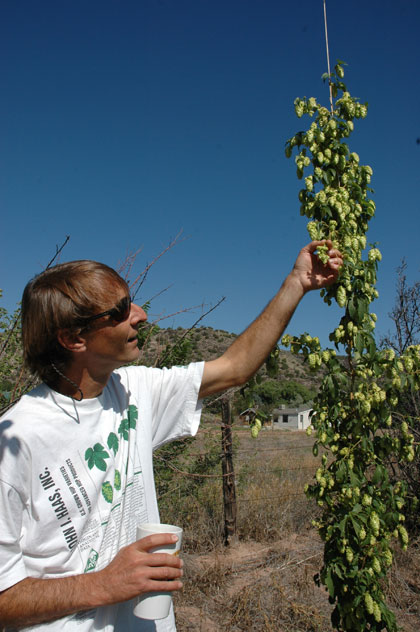Elsewhere bloggers are posting for Session #90 today, but I’m not feeling in a fighting mood.
Instead it seems more timely to show you a few photos from Embudo, New Mexico, because the link I posted yesterday on Twitter to a Smithsonian article about neomexicanus hops sure struck a chord with some people. I’m quoted in the story, but you can pass on that part. And take the headline with a grain of salt (“Will it change the way we think of American beer?”).
Sierra and I visited Todd Bates’ farm six years and 49 weeks ago. We called it a field trip (this was before she escaped our clutches for full-time public school). I wasn’t even committed to write “Brewing With Wheat” at the time, and I sure as heck had no idea I’d end up writing a book about hops. It’s more than a little strange to look back at these photos and think that I’d be explaining neomexicanus hops to people. It might have been simpler had Bates (pictured below) found the hops in Arizona or Colorado. That he cultivated neomexicanus in New Mexico is something of a coincidence, but more on that soon. For now, the photos.




I’m pretty stoked that neomexicanus hops are no longer being ignored or worse, treated as a plant to be eradicated. They’re quite worthy,, and they do have great virtue. Tom’s quite right about the extra buzz in neomexicanus hops. I noticed it all these years of brewing and evaluating different neomexicanus hops. I wonder what it is? I also wonder why Euro hops leave a gluey scudge on the tongue and palate when neomexicanus hops don’t.
“Jobs for plants, plants for jobs”,,, and this weed just got promoted. 😉
You aren’t biased are you, Todd?
When you write “gluey scudge” do you mean European landrace hops (aka Saaz, Hersbrucker) or does that include varieties that have both European and American in their background?
Yes Stan, I’m biased. I must add though,, I became biased after I brewed for so many years with the neomexicanus hops I was breeding. I became enamored with the flavors. I wanted us all to be able to taste what I had been tasting, so I had to finish my part in the project and get these plants to Eric at CLS Farms so he could either help prove them worthy or release me from my task of trying to get this “weed” a job. I am biased about trying to get native plants into modern agriculture as one of my goals is, “Jobs for plants, plants for jobs”. As far as describing the “gluey scudge”, I’m not sure I took note of any Euro hops I didn’t notice having it? I brewed the same recipe for years, one that Brad Kraus taught me. It’s goal was to evaluate the hop and not have hop flavors hide behind sugars. It was simple light DME in 10 gal batches, 3 additions of hops over a one hour rolling boil,,, crash cool,,, add Safale SO-4,,about a 1.050- 1.040 SG,,, rack it at 5 days,, let finish for a total of 2 weeks,, often dropped to about 1.008 FG,, and either bottle condition or keg and let rest for 2 weeks. I did this same brew for quite a few hops. I never noticed the Euro flavor in any of the “winning” neomexicanus hops. I had some super duper loser neomexicanus hops though that were absolutely horrible tasting,,, and far beyond nasty. People would drink whatever was brewed,, Euro or neomexicanus,,, but some of the breedings of neomexicanus were horrible tasting and those brews were dumped into the garden.
Todd, I also read the Smithsonian article and now I can’t wait to try brewing some beer with some neomexicanus hops. Can you offer some advice on how a simple, yet enthusiastic homebrewer like me could obtain some of these hops in 2014? Is Medusa the variety I ought to try brewing with? Sincere thanks for the work you are doing.